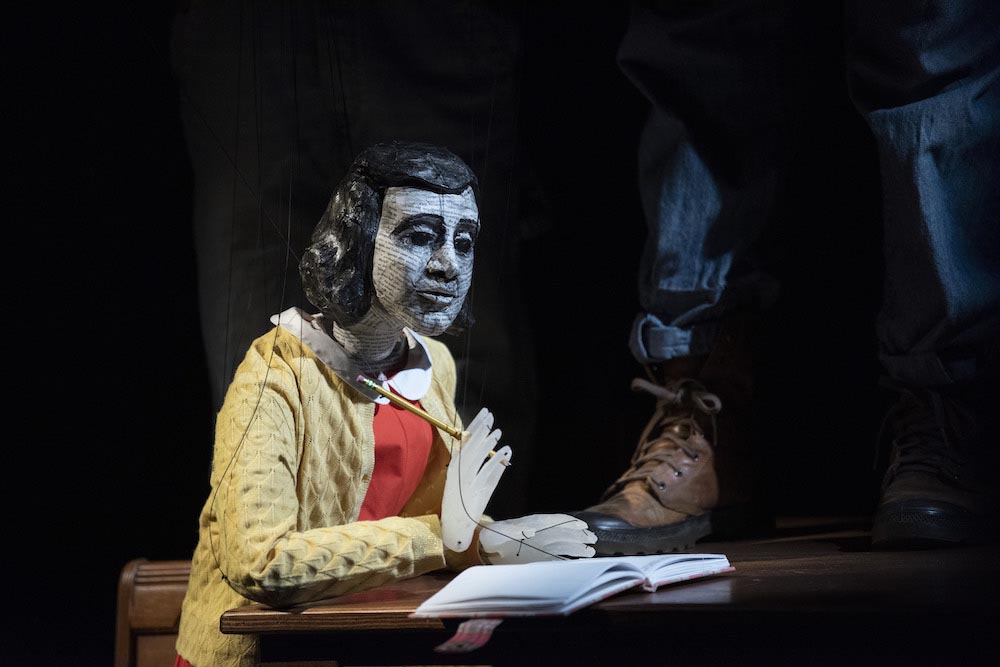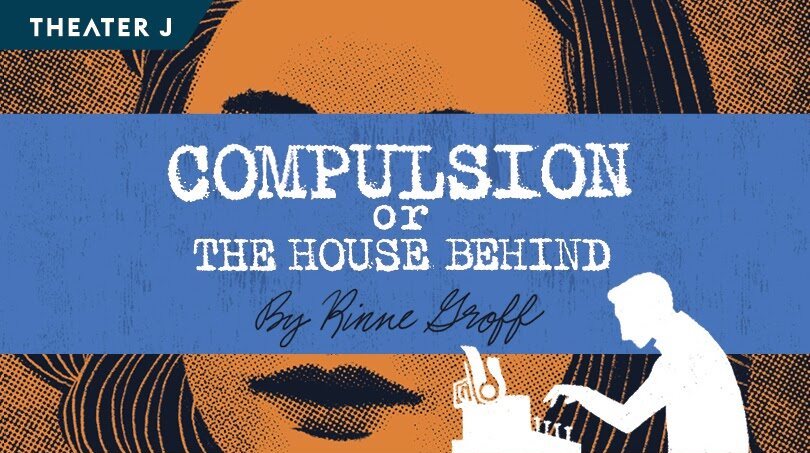Rinne B. Groff’s Compulsion or the House Behind, now playing in an engrossing production at Theater J, is a crafty work of theater very much worth a look … or two, as it seems best seen with a kind of double vision.
On its face, the semifictional drama is an intellectual-property-rights procedural with puppets. That’s what structures the plot. The protagonist wants to write a play based on a dead author’s literary material that he thought he had the dramatic rights to — but he really didn’t. A pair of more-successful dramatists got the rights, direct from the dead author’s dad, and their play based on the adapted work becomes an international smash. Meanwhile, the protagonist’s frustratingly futile quest to get his own unauthorized play commercially produced stretches for decades. His perfervid zeal becomes an obsession (hence the play’s title, Compulsion). His trigger temper keeps combusting. He becomes more and more combative, belligerent. He annoys just about everyone except the original author, who appears to him as a kindly and optimistic marionette.
At the same time, in its heart, Compulsion the play aches with memory of a harm beyond telling. A wound beyond healing. And how one regards (with double vision) both that heart and the play’s plot can make for a deeply reflective experience, perhaps beyond description.

The original author in question is Anne Frank. The contested literary material is the diary she kept while hiding in the Achterhuis (“the house behind”) before she was sent to her death. What happens during the play thus engages mind and emotion in interwoven ways, because that historically fraught Holocaust backstory infuses a cautionary case study in IP law and transforms it into a powerful meditation on the meaning of being a Jew.
The playwright, writing in a program note excerpted from the preface to her 2010 script, says as much: “Without the writer Anne Frank and her contributions to the world, none of this work holds any meaning.”
As we enter the theater we hear a preshow track of 1950s-era big band swing music (sound design by Sarah O’Halloran), and we can make out under work lights the bare-walls stage set with tall stepladders, an assortment of tables, and surreally suspended chairs (set design by Nephelie Andonyadis). When the stage lighting comes up (designed by Jesse W. Belsky), we see beside a ghost light the teenage Anne Frank as a marionette writing in her diary — operated with breathtaking precision and grace by two preternaturally dextrous puppeteers, Matt Acheson and Eirin Stevenson. Instantly we are drawn into Anne’s telling.
Groff has the puppet recite a monologue that ends with the young diarist’s famously faith-filled words: “In spite of everything I still believe that people are really good at heart.” Underscoring the centrality of Anne Frank’s moral and emotional resonance, the puppet will say so again three more times during the play.

We next meet Sid Silver, an author who insists that Otto Frank, Anne Frank’s father, gave him oral permission to turn her diary into a play. The excellent Paul Morella as Sid conveys the character’s litigious idée fixe with a verve that fits the script but may well get on one’s nerves. The fact that what drives Sid is his deep devotion to Anne Frank is pretty much all that redeems him (“That’s my only mission now: to help the teller to tell”). Ironically, it’s also all that makes him seem really good at heart.
Two other terrific actors play multiple roles: Marcus Kyd appears as various characters in publishing, law, and theater (Mr. Thomas, Mr. Harris, Mr. Ferris, Mr. Matzliach, Mr. Williams), and he does so with such versatility that one forgets they’re all the same actor. Kimberly Gilbert is absolutely transfixing as both Miss Mermin (a prim and rising editor at Doubleday) and Mrs. Silver (Sid’s younger and French-born wife, who adores him sensuously … until she’s seriously had it with him).

Gilbert has an extraordinary talent for sharing her character’s fascinating flux of feelings by frequently flashing her face to the house. So winning is her expressive performance that one might well wish the play was really all about her. At the end of Act One, Gilbert delivers a play-stealing scene that is one of those stunners one never forgets. She’s in character as Mrs. Silver, in a drenched nightgown (costumes are by Sarah Cubbage), just come in from the rain, near-suicidal with rage over Sid’s obsession with Anne and the diary, and she gives him an ultimatum:
MRS. SILVER: You pick up the phone and you tell the lawyer to drop everything. All the suits and countersuits. Tomorrow. No, tonight. You will call him now, end this pursuit now. Or I swear on every breath of my sleeping children, you will lose me forever.
Boom. Intermission.
To be sure, Sid Silver has grounds for indignation and resentment, or as one character calls it his “persecution mania.” The script is littered with antisemitic microaggressions Sid faces in his quest. And in his outrage over the dramatic adaption that became a hit (co-authored by a Jew and a non-Jew), he makes a credible case: “At every turn so far, they’ve de-Judaized the thing.” Still, as another character tells him, “You’re a total pain in the ass and no one wants to deal with you.”
Director Johanna Gruenhut deserves high praise for the show’s riveting pace and ingenious use of the “backstage” set. The play in a sense is as much about being a Jew as it is about being in theater. And Matt Acheson, who designed, built, and directed manipulation of the puppets, should get a special award for instilling humanity in inanimate marionettes.
Running Time: Two hours 5 minutes, including a 15-minute intermission.
Compulsion or the House Behind plays through February 20, 2022, presented by Theater J at Edlavitch DCJCC’s Aaron & Cecile Goldman Theater, 1529 16th Street NW, Washington, DC. Purchase in-person tickets ($35–$70) online or by calling the ticket office at 202-777-3210.
Compulsion or the House Behind also streams from February 8 to 20, 2022. Streaming tickets ($60, good for viewing 10 AM to 11:59 PM ET), can be purchased online or by calling the ticket office at 202-777-3210.
The program for Compulsion or the House Behind is online here.
COVID Safety: In accordance with the Edlavitch DCJCC policy, all individuals will be required to show proof of full vaccination each time they enter the EDCJCC by presenting either digital documentation on a smartphone or a physical copy of their vaccination card. Fully vaccinated means either that 14 days have passed since receiving the second dose of an FDA- or WHO-authorized double-dose vaccine or since receiving the sole dose of an FDA- or WHO-authorized single-dose vaccine. Individuals with medical or religious exemptions to vaccinations will be required to show proof of a negative COVID-19 PCR test taken within 72 hours of their arrival to the EDCJCC. Mask wearing will be required inside of the building by all people at all times. Only performers and guests invited on stage may be unmasked. Complete Edlavitch DCJCC Safety Guidelines are here.
SEE ALSO:
Theater J’s Johanna Gruenhut on why ‘Compulsion’ matters now (interview by Ravelle Brickman)
Theater J program aims to diversify depictions of Jewishness onstage (season announcement)





